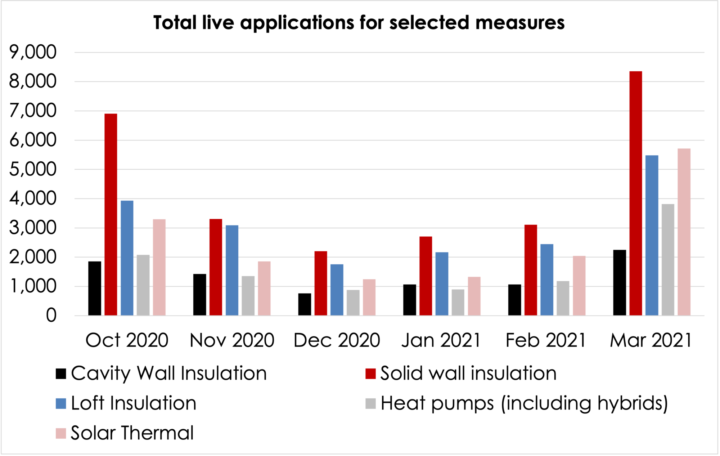Green Homes Grant: turning a mess into a marvel
Building on a late surge in demand, what lessons can be learned for the successor to the Green Homes Grant?

By Jess Ralston
@jessralston2Share
Last updated:
A plan to decarbonise Britain’s homes is the major missing piece from national action on climate change, with ministers and policy makers currently poring over options for a replacement for the blighted Green Homes Grant scheme.
Despite its multitude of failings, government data on the now-closed scheme gives a valuable insight into public enthusiasm for home upgrades and offers a wealth of insight into how a replacement can be best designed. This blog runs through three of the main lessons.
Popular
It is now abundantly clear that the pretence of the scheme not attracting applications is not true.
Final figures show over 160,000 applications submitted in just six months, with a surge just before it was scrapped. A distinct message has been sent for its successor: the public is up for decarbonised homes, as long as the support is there.
Even before the scheme opened, the popularity of the Government’s flagship home energy efficiency scheme was clear. Despite lockdowns amid winter months when renovation works are generally fewer, applications were consistently high – a blessing for local businesses after a rough year.
Even with the closure for new applications announced with just four days' notice, the last month saw more than 41,000 applications: families keen to grasp the opportunity before it disappeared.

The main lesson for the successor scheme lies in this demand. Such enthusiasm even when the application process was trickier to navigate than the Suez Canal should give ministers and policy makers confidence that a more accessible programme can bring real action on emissions from the UK’s homes.
North and Midlands lead applications
Countless reports detailing the benefits of ‘building back greener’ showed how England’s regions could benefit. Now government data backs that up.
Families living in the North and Midlands were keenest for green home upgrades – no surprise when home energy performance ratings and fuel poverty rates are worse in these areas.
Weighted for population, some northern regions had double the number of applications than London and the South East (eight compared to four), illustrating the importance of this scheme in bettering homes in areas that need it most.
| Region | Live vouchers applied for per 1,000 households | Total applications | % total applications | Households in fuel poverty |
|---|---|---|---|---|
Yorkshire and the Humber | 8.1 | 18,455 | 14.0% | 10.1% |
North West | 7.9 | 24,437 | 18.5% | 12.1% |
West Midlands | 7.3 | 17,304 | 13.1% | 11.4% |
East Midlands | 6.3 | 12,433 | 9.4% | 10.9% |
North East | 5.6 | 6,424 | 4.9% | 9.5% |
South West | 5.2 | 12,144 | 9.2% | 9.4% |
East | 5.1 | 12,894 | 9.8% | 9.4% |
South East | 4.1 | 15,153 | 11.5% | 7.9% |
London | 3.7 | 12,635 | 9.6% | 11.4% |
Now the evidence is in, and clearly shows the potential for home retrofits to improve the regions – any successor scheme will surely want to take these findings into account.
Popularity boost for ‘trickiest’ changes
The data also signals a change in thinking around measures typically thought to be unpopular, like solid wall insulation and low carbon heat.
In fact, in the Green Homes Grant these measures made up a fifth of the total applications each (more than 52,500 combined) – a clear sign that the people are ready to take bold action to reduce emissions and bills.
The perceptions that Brits are either wedded to their gas boilers, or unwilling to accept the disruption associated with extensive insulation works are not backed up by any evidence.

Over 7.7 million homes with solid walls still require efficiency upgrades in Great Britain. Progress has been slow with just 200,000 solid wall homes insulated since 2013.
However, with over 8,300 households applying for this measure in one month alone under the Green Homes Grant, the data shows attitudes may be changing. At this rate, around 100,000 hard-to-treat homes per year could set on the path to net zero, a massive three-fold increase on the average over the last seven years.
Similarly, a high number of applications undermines the notion of a public resistance to clean heat. Around 2,900 heat pumps applications in the Green Homes Grant in March 2021 would result in roughly 35,000 heat pumps installed in a single year, already equal to sales in 2019.
Solar thermal shows a similar success story – in the final month of the scheme applications more than doubled to 5,700, at that rate equalling around 70,000 per year. With this popularity, solar thermal could bolster the different routes to net zero that the Government is currently considering, however the Climate Change Committee do not have a target for solar thermal within the 6th Carbon Budget.
Despite its short lifetime, data on the scheme provides a valuable insight into public enthusiasm for real actions to decarbonise homes. Hopefully the impending Heat and Buildings Decarbonisation Strategy will take them into account.
Share